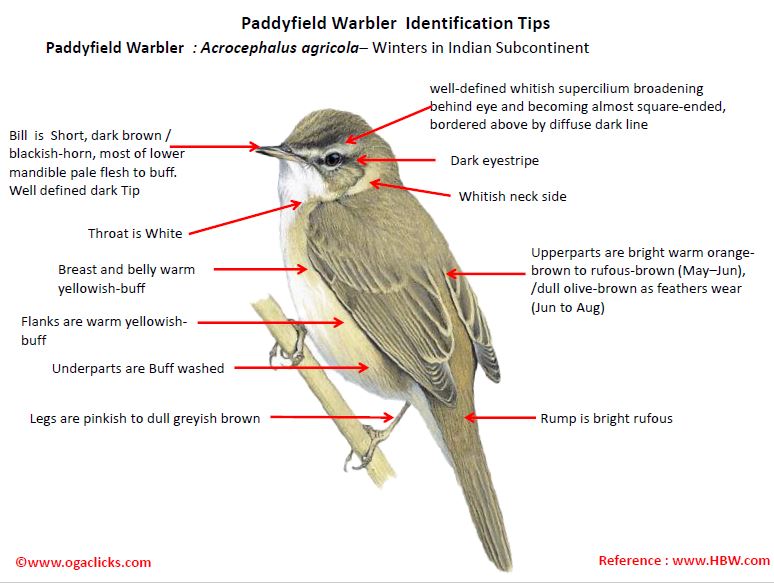Paddyfield Warbler

Paddyfield Warbler Acrocephalus agricola
Etymology:
- Acrocephalus:Greek word akros –topmost, highest ; kephale–head
- Agricola: Latin word ager-field; cola –dweller
Vernacular Names: Guj: Kamodnotiktiki, Nano karkariyo, Te: Yerra-kumpa-jitta, Mal: Patakkuruvi, Mar: DhanVatvatya
Distribution in India: Winter Visitor in Western coast and hills and plains of Eastern Himalayas.
Description: Size of 12-13 cm.It is an unstreaked reed-warbler with particularly distinct supercilium, relatively short bill, long and distinctly rounded tail, plumage coloration very variable owing to quick loss of feather tips and general wear. The nominate race has well-defined whitish supercilium broadening behind eye and becoming almost square-ended, bordered above by dark line and below by dark eyestripe; often whitish neck side; upperparts bright warm orange-brown to rufous-brown in fresh plumage (May–Jun), increasingly dull olive-brown as feathers wear (late Jun to Aug), rump and uppertail-coverts always contrasting, often bright rufous; tertials have dark brown to almost black centers, contrasting paler edges; throat whitish, chest side, flanks and vent warm yellowish-buff, belly paler; iris dark brown; bill dark brown or blackish-horn, most of lower mandible pale flesh to buff; legs pinkish to dull greyish-brown. Both the sexes look similar.
Habitat: It is found duringbreeding season in reeds, low-growing and open, neighboring bushes, often on landward edges of lakes and in river valleys. In non-breeding quarters require damp or wet ground and thick cover, e.g. standing rice, reedbeds, sugar cane, elephant grass or grass of any height, tamarisks and sedges. On migration occurs in tall grass of marshy meadows, in thickets and even in small trees.
Food Habits: It eats mayflies, dragonflies, bugs, caddis flies, flies, hymenopterans, beetles, spiders and earthworms. When foraging, moves close to ground among reeds and tall grasses, catching small insects close to the water or snapping them up directly from water’s surface. Also performs flycatching from tops of reeds, and moves almost acrobatically in outer branches of trees or shrubs.
Breeding Habits: They breed in April- June in Turkey, Aral Sea coast and Black sea region.The nest is built by both sexes. The nest is cylindrical, rather tall and deep, loosely constructed from reed and grass stems and leaves and reed inflorescences, woven around vertical stems of water plants, lined with finer grasses, reed flowers and occasionally plant down, suspended up among vertical stems of emergent aquatic or semi-aquatic vegetation, over water or land. They lay a clutch of 5-6 eggs. The incubation is done by female for a period of11-12 days. The fledging period is 10-11 days. The chicks fed by both parents.